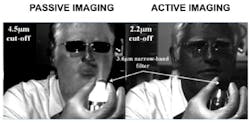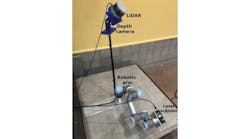Existing infra-red cameras usually fall into one of two types: active cameras, which use an infra-red source to illuminate a scene in the near or short-wavelength infra-red and passive cameras, which detect the thermal radiation given off by a warm object, typically in the mid- or long-wavelength infra-red without the need for any illumination.
Integrating both modes of imaging into a single camera would open new possibilities but doing so has proven challenging. Until now, dual-mode active and passive infra-red cameras needed either two different infrared detectors or controllable filters to accommodate the different wavelengths, and then required additional signal processing to reconstruct a single image from the two modes.
However, researchers at the Northwestern University's (Evanston, IL, USA) Center for Quantum Devices have now found a way to integrate active and passive infra-red imaging capability into a single chip. This opens the way to lighter and simpler dual-mode active/passive cameras with lower power dissipation.
The researchers created the dual-band detector capable of active and passive use by engineering the properties of indium arsenide/gallium antimonide (InAs/GaSb) type-II superlattices. The detector has a cutoff wavelength of either 2.2µm in the active mode or 4.5µm in the passive mode. It can be switched from passive to active mode by a very small change in bias.
The image above shows a researcher holding a heater and a narrow-band filter centered at 3.6µm. The heater can be seen when imaged with the band-pass detectors sensitive up to 4.5µm (left), but not in the ones with shorter detection wavelengths up to 2.2µm (right).
A paper about the findings, "Active and Passive Infrared Imager Based on Short-Wave and Mid-Wave Type-II Superlattice Dual-Band Detectors," was published in the January 1 issue of the journal Optic Letters.
Further details of the work, which was led by Manijeh Razeghi, Walter P. Murphy Professor of Electrical Engineering and Computer Science in Northwestern's McCormick School of Engineering and Applied Science, can be found here.
Related articles from Vision Systems Design that you might also find of interest.
1. An infra-red comeback for the beetles
A team of German researchers from the University of Bonn (Bonn, Germany) have concluded that the sensors of black fire beetles might even be more sensitive than un-cooled infrared sensors designed by man.
2. Infra-red detectors made from nanotubes
A team of researchers from Peking University, the Chinese Academy of Sciences, and Duke University (Durham, NC, USA) has harnessed the properties of Single-Walled Carbon Nanotubes (SWNTs) to create a highly sensitive, un-cooled photovoltaic infra-red detector.
3. Infra-red system shows up veins
Frimley Park Hospital has become the first hospital in the UK to use specialized imaging equipment to make a common clinical process much less painful for patients.
Vision Systems Design magazine and e-newsletter subscriptions are free to qualified professionals. To subscribe, please complete the form here.
-- Dave Wilson, Senior Editor, Vision Systems Design





